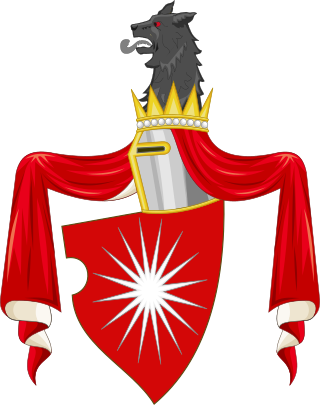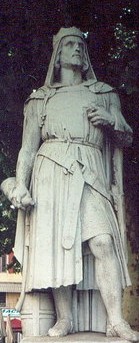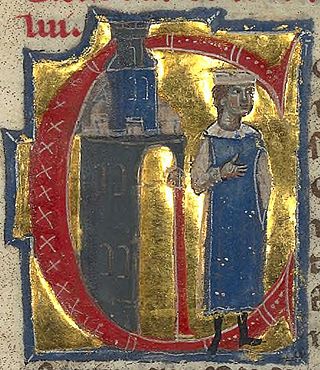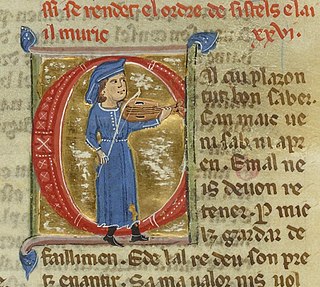Related Research Articles

Prince of Orange is a title associated with the sovereign Principality of Orange, in what is now southern France and subsequently held by the stadtholders of, and then the heirs apparent of, the Netherlands.

This is a list of the Lords, Barons and Marquisses of Baux.

Raimbaut of Orange was the lord of Orange and Aumelas and an influential troubadour in medieval France. His properties included the towns of Frontignan and Mireval. He was the only son of William of Aumelas and of Tiburge, Countess of Orange, daughter of Raimbaut, Count of Orange. After the early death of his father, Raimbaut's guardians were his uncle William VII of Montpellier and his elder sister Tibors.
Barral of Baux was Viscount of Marseilles and Lord of Baux. He was the son of Hugh III of Baux, Viscount of Marseilles, and Barrale.

Azalais de Porcairagues or Alasais de Porcaragues was a trobairitz, composing in Occitan in the late 12th century.
Raymond Geoffrey, Viscount of Marseille, usually called Barral of Marseille, was the third son of Hugh Geoffrey of Marseille and his wife Cécile of Aurons. Barral of Marseille was a patron of troubadours, including Folquet of Marseille and Peire Vidal.
The Baussenque Wars were a series of armed conflicts (1144–1162) between the House of Barcelona, then ruling in Provence, and the House of Baux. They are held up in Provence as the idealistic resistance by one of her native families against Catalan "occupation." In reality, they were the first of many successful expansions of Catalan power and influence in the Mediterranean world.

The House of Baux is a French noble family from the south of France. It was one of the richest and most powerful families of medieval Provence, known as the 'Race d’Aiglon'. They were independent lords as castellans of Les Baux and Arles and wielded very considerable authority at the local level. They held important fiefs and vast lands, including the principality of Orange.
Aicard of Marseilles, also known as Aicard of Arles or simply Aicard, was the Archbishop of Arles from 1070 to 1080 and again from 1107 to his death.
Gui Guerrejat was the fifth son of William VI of Montpellier. When still a boy, in 1146, he inherited the castles of Paulhan and le Pouget from his father.

Raimbaut II, Count of Orange was the elder son of Bertrand Raimbaut and of his first wife Gilberte.

Guilhem de Saint-Leidier, also spelled Guilhem de Saint Deslier, Guillem de Saint Deidier and Guilhèm de Sant Leidier was a troubadour of the 12th century, composing in Occitan. He was lord of Saint-Didier-en-Velay, was born at some date before 1150, and died between 1195 and 1200. He was said to have loved Belissende, sister of Dalfi d'Alvernha and wife of Eracle III of Polignac, Guilhem's feudal overlord.

Matthew, Count of Boulogne, also known as Matthew of Alsace was the second son of Thierry, Count of Flanders and Sibylla of Anjou. Matthew forcibly abducted the nun Marie de Boulogne, daughter of Stephen, King of England, and constrained her into marriage, claiming the title of Count of Boulogne jure uxoris in 1160. The forced marriage was opposed by the Church and finally annulled in 1170, but he continued to rule as count until his death.
Tibors de Sarenom is the earliest attestable trobairitz, active during the classical period of medieval Occitan literature at the height of the popularity of the troubadours.

Perdigon or Perdigo was a troubadour from Lespéron in the Gévaudan. Fourteen of his works survive, including three cansos with melodies. He was respected and admired by contemporaries, judging by the widespread inclusion of his work in chansonniers and in citations by other troubadours.
William I of Baux was the Prince of Orange from 1182 until his death. He was an important Provençal nobleman.
William III of Baux was a son of William II of Baux. Following his father and grandfather, William III carried the title of prince of Orange. The title had come to the House of Baux through a brother, Raimbaut of Orange, of William III's paternal great-grandmother, Tiburge de Sarenom, the latter also referred to as Tiburge princess of Orange.
Raimbaut is a given name. Notable people with the name include:
Adémar II de Poitiers, known in Old Occitan as Ademar or Aimeric de Peiteus, was the count of Valentinois and de facto ruler of Diois from 1188 or 1189 until 1230. He was the son of Count Guillaume and grandson of Count Adémar I. He married Philippa, daughter of Guillaume-Jourdain, the lord of Fay, and Météline de Clérieu. The Finnish scholar Aimo Sakari hypothesised that Philippa of Fay was the famous trobairitz known as the Comtessa de Dia, and that the friend (amic) mentioned by the Comtessa in her poems was the troubadour Raimbaut de Vaqueiras. Around 1195–96, Adémar himself participated in a three-way torneyamen with Raimbaut de Vaqueiras and Perdigon.
Tiburge of Orange, was a suo jure ruling countess regnant of Orange from 1115 to 1150.
References
- Jeanroy, A. (1931). "Études sur l'ancienne poésie provençale. Cinquième article". Neuphilologische Mitteilungen. 32 (1/3): 8–24.
- A. Sakari, 'Azalais de Porcairagues, le "Joglar" de Raimbaut d'Orange' in Neuphilologische Mitteilungen vol. 50 (1949) pp. 23–43, 56–87, 174–198.